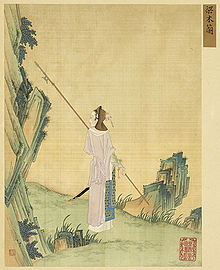Hua Mulan
| Hua Mulan | |||||||||||||||||||||||||

Mulan as depicted in the album Gathering Gems of Beauty (畫麗珠萃秀)
|
|||||||||||||||||||||||||
| Traditional Chinese | |||||||||||||||||||||||||
|---|---|---|---|---|---|---|---|---|---|---|---|---|---|---|---|---|---|---|---|---|---|---|---|---|---|
| Simplified Chinese | |||||||||||||||||||||||||
|
|||||||||||||||||||||||||
| Transcriptions | |
|---|---|
| Standard Mandarin | |
| Hanyu Pinyin | Huā Mùlán |
| Wade–Giles | Hua1 Mu4-lan2 |
| Gan | |
| Romanization | Fa1 Muk6-lan4 |
| Hakka | |
| Romanization | Fa Muklan |
| Yue: Cantonese | |
| Jyutping | Faa1 Muk6-laan4 |
| Southern Min | |
| Hokkien POJ | Hoe Bo̍k-lân |
Hua Mulan (Chinese: 花木蘭) is a legendary woman warrior from the Southern and Northern Dynasties period (420–589) of Chinese history, who was originally described in a ballad known as the Ballad of Mulan (Chinese: 木蘭辭). In the ballad, Hua Mulan takes her aged father's place in the army. She was known for practicing martial arts such as kung fu and for being skilled with the sword. She fought for twelve years and gained high merit, but she refused any reward and retired to her hometown instead.
The historical setting of Hua Mulan is in the Northern Wei. Over a thousand years later, Xu Wei's play from the Ming dynasty places her in the Northern Wei (386–536), whereas the Qing dynasty Sui Tang Romance has her active around the founding of the Tang c. 620. In 621, the founder of the Tang dynasty was victorious over Wang Shichong and Dou Jiande, the latter was the father of Dou Xianniang, another female warrior who became Mulan's laotong in the Sui Tang Romance.
The Hua Mulan crater on Venus is named after her.
The Ballad of Mulan was first transcribed in the Musical Records of Old and New (Chinese: 古今樂錄) in the 6th century. The earliest extant text of the poem comes from an 11th or 12th century anthology known as the Music Bureau Collection (Chinese: 樂府詩). Its author, Guo Maoqian, explicitly mentions the Musical Records of Old and New as his source for the poem. As a ballad, the lines do not necessarily have equal numbers of syllables. The poem consists of 31 couplets, and is mostly composed of five-character phrases, with a few extending to seven or nine.
...
Wikipedia
